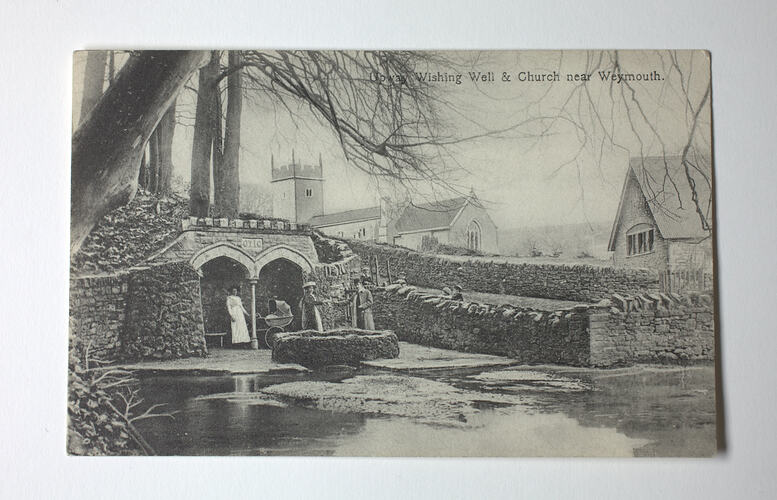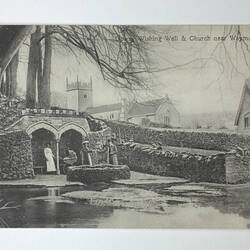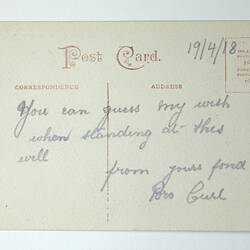Summary
Black and white photograph of the Upwey (or Upway) Wishing Well in Dorset, England.
The Upwey Wishing Well has been a popular tourist attraction since the 18th century. It is unclear whether the well was originally healing or oracular in nature; however local tradition holds that the well is a healing well, particularly for sore eyes. The traditional method at the well for making a wish is to take a few sips of the water from the well (a step that is no longer advised) and to throw the remainder over the left shoulder whilst making a wish. An arched seating area was added in 1887 to commemorate Queen Victoria's Golden Jubilee and a garden was later added to mark the Golden Jubilee of Queen Elizabeth II. The site has further connections to the monarchy as it was reportedly a favourite place of King George III who used to visit the well from nearby Weymouth.
The church shown in the background of the postcard is that of St Laurence, famous for its Tudor Roses painted in the late 15th century. The oldest parts of the church date back to 1490 and is has undergone several renovations since that time, the most recent dating from 1906 when chancel was enlarged before being rededicated by the Bishop of Salisbury. Today the church is part of the diocese of Salisbury and part of the Church of England.
Part of a collection of material relating to the World War I service of brothers John and Albert Victor Peile. The postcard is signed by 'Curl.' 'Curl' seems to be a reference to John Peile as the return address listed on ST 40698 has his name and regiment.
John and Albert Victor Peile both died in the conflict. Younger brother Albert enlisted first. He was a 22-year-old unmarried clerk when he enlisted on 27 August 1914, service number 769, 3rd Battalion. He served in Gallipoli and later France, and was eventually promoted to the rank of corporal. He died in Bullecourt, France on 4 May 1917; his body was never found. He is commemorated at the Villers-Bretonneux Memorial. His brother John Peile was a 38-year-old unmarried miner when he enlisted on 25 June 1915, service number 2662, 2nd Battalion. He also served in in Gallipoli and France, and was similarly promoted to corporal. He died in France on 18 September 1918 and is buried at Roisel Communal Cemetery Extension, France. Their mother died only a few years later in 1926, aged 73.
Their niece was Mrs M. J. Hitchens, the donor. Margaret Joan Hitchens (1916-?) was the daughter of Albert and John's sister Alice and her husband John Henry Dinwoodie.
Description of Content
Wishing well, bridge with stone sides and buildings around, with three people and pram at centre.
Physical Description
Black and white photograph printed on paper.
More Information
-
Collection Names
-
Collecting Areas
-
Acquisition Information
Donation from Victorian Branch, Returned & Services League of Australia Limited (RSL), Mrs Margaret J. Hitchens, 1986
-
Author
Corporal John '. Peile - Australian Imperial Force (AIF), 19 Apr 1918
-
Place Depicted
-
Inscriptions
Printed on front: 'Upwey Wishing Well & Church near Weymouth.' Printed on back: 'POST CARD. / CORRESPONDENCE ADDRESS' Printed on back top right corner: 'INLAND / POSTAGE / 1/2d. / FOREIGN / POSTAGE / 1d.' Handwritten on back: '19/4/18 / You can guess my wish / when standing at this / well / from yours fond / Bro Curl' Printed vertically on back left: 'E.H. Series. Printed in England'
-
Classification
-
Category
-
Discipline
-
Type of item
-
References
'Upwey,' at: [Link 1] accessed: June 22, 2012 'The Upwey Wishing Well,' Dark Dorset at:[Link 2] accessed: June 22, 2012 'Upwey, Dorset, England,' History and Heritage of Weymouth and Dorset Area, at: [Link 3] accessed: June 22, 2012 'Boncombe's link to ancient spring,' Dorset Echo: Dorset Diary, March 10, 2004, at: [Link 4] accessed: June 22, 2012 'Upwey,' UK Genealogy Archives, at: [Link 5] accessed: June 22, 2012 'Upwey: St Laurence,' Church of England, at: [Link 6] accessed: June 22, 2012 For Albert Peile's war record see the National Archives of Australia website at: [Link 7] For John Peile's war record see the National Archive of Australia website at: [Link 8]
-
Keywords


